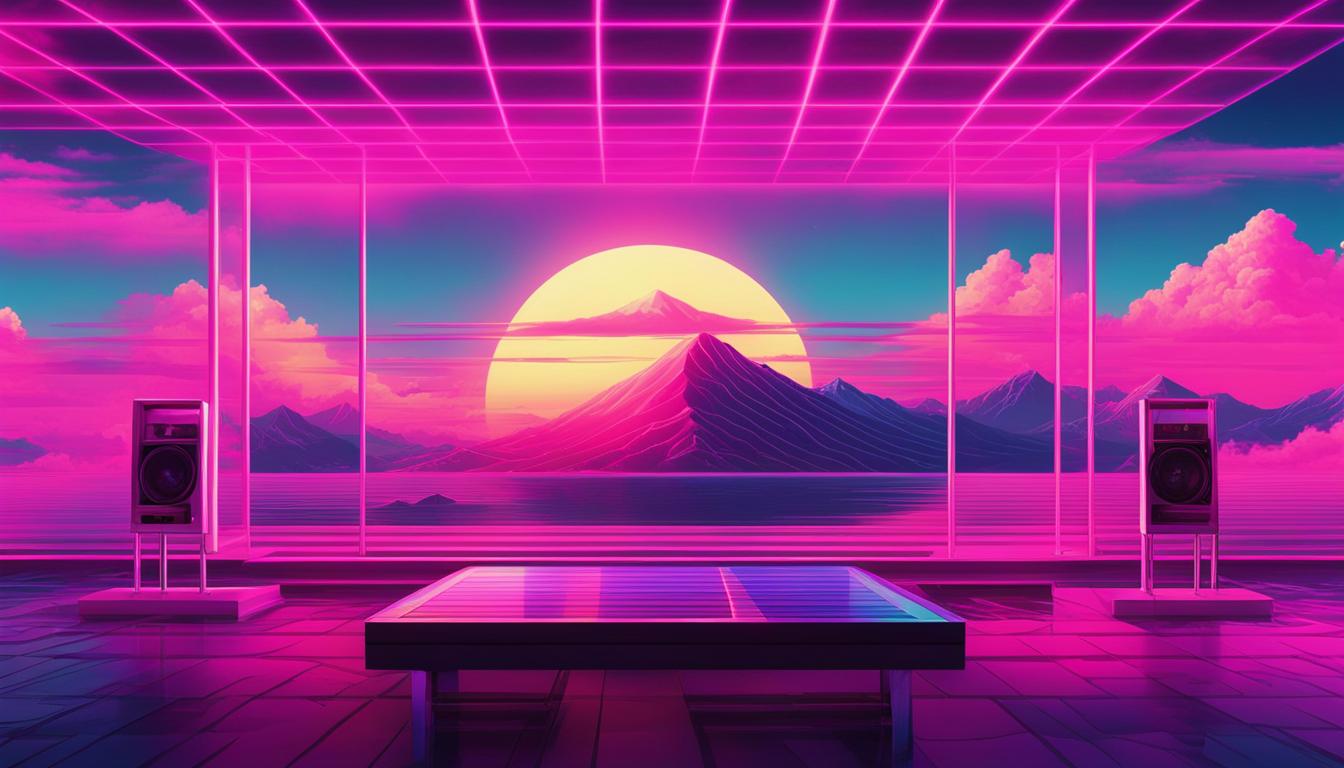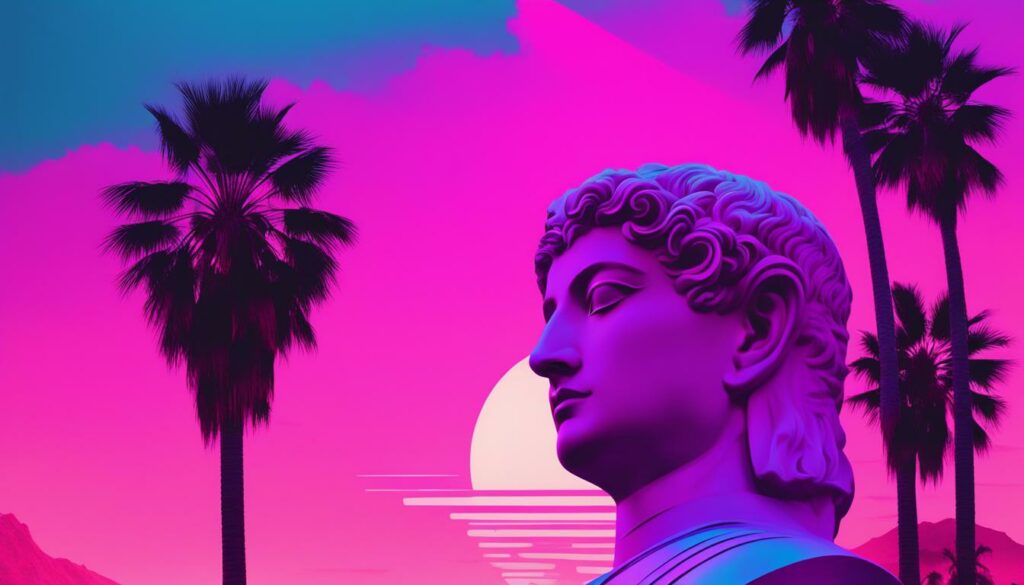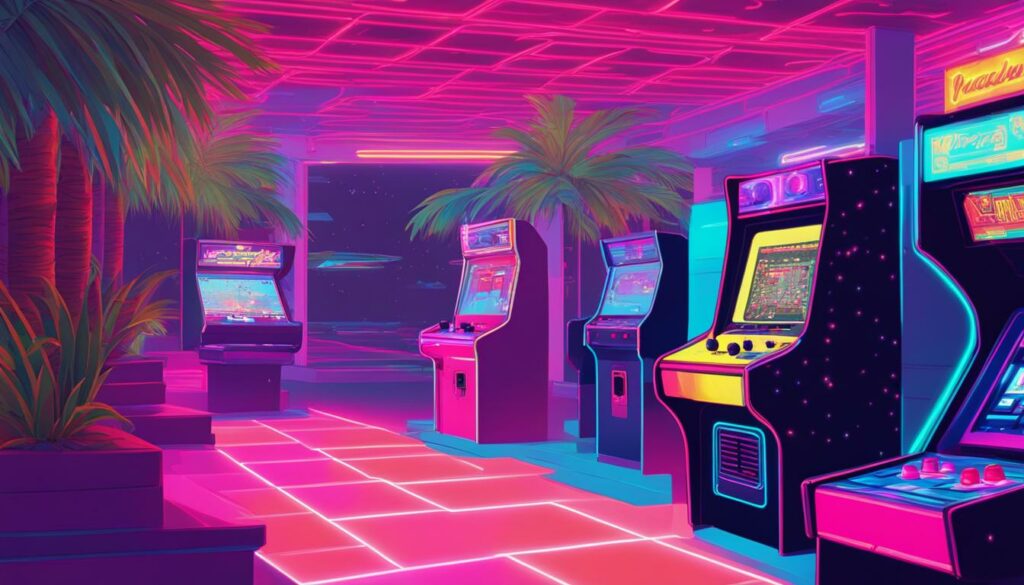No products in the cart.

Vaporwave is a unique microgenre of electronic music and a subgenre of Hauntology that emerged in the early 2010s and gained popularity in 2015. It is characterized by its slowed-down, chopped and screwed samples of smooth jazz, 1970s elevator music, R&B, and lounge music from the 1980s and 1990s. But Vaporwave is more than just music. It has a distinct aesthetic that incorporates early Internet imagery, late 1990s web design, glitch art, anime, stylized Greek sculptures, 3D-rendered objects, and cyberpunk tropes.
Vaporwave is often associated with an ambiguous or satirical take on consumer capitalism and pop culture, and it has influenced various art forms including fashion and video games. Despite being labeled as a “dead” genre, Vaporwave continues to inspire and influence artists in the music and art scenes, and it has evolved into various subgenres and offshoots such as future funk, mallsoft, and hardvapour.
Vaporwave is not only a music genre but also an art form with a distinct visual aesthetic. The visuals and inspirations for Vaporwave draw from a variety of sources, including retro computer graphics, Roman busts, city skylines, malls, classical sculptures, consumerism, and iconic brands. The aesthetic often incorporates bright pastel colors, pink and teal tones, glitches, and Japanese characters. Vaporwave’s visual identity is heavily influenced by ’80s and ’90s consumer culture and aims to evoke nostalgia for a bygone era while also critiquing it. It embraces elements of retrofuturism, cyberpunk, and surrealism in its artwork.
One of the key inspirations for Vaporwave visuals is retro computer graphics. This includes pixel art, glitch effects, and early digital aesthetics. These elements create a sense of nostalgia for the early days of the internet and the technological advancements of the past. Roman busts and classical sculptures are also frequently used in Vaporwave artwork, adding a touch of sophistication and cultural references to the aesthetic.
Malls and city skylines are another source of inspiration for Vaporwave visuals. The imagery of deserted shopping malls and neon-lit cityscapes creates a sense of urban decay and isolation, which ties into the genre’s critique of consumerism and capitalism. Vaporwave also incorporates iconic brands and logos, often distorted or altered, to comment on the influence of corporate culture and branding on society.
“Vaporwave’s visual identity is heavily influenced by ’80s and ’90s consumer culture and aims to evoke nostalgia for a bygone era while also critiquing it.”
The use of bright pastel colors, pink and teal tones, is a defining characteristic of Vaporwave aesthetics. These colors create a dream-like, ethereal atmosphere and contribute to the overall nostalgic vibe of the genre. Glitches and Japanese characters are also commonly used in Vaporwave visuals, adding a sense of digital distortion and global influences to the aesthetic.
Overall, Vaporwave’s visuals and inspirations are a reflection of the genre’s cultural critique and nostalgic references. Through a combination of retrofuturism, cyberpunk, and surrealism, Vaporwave creates a unique visual identity that continues to captivate and inspire artists and fans alike.
Vaporwave music is at the core of the Vaporwave genre, serving as its sonic foundation. The genre is known for its innovative use of samples, drawing primarily from the pool of music from the 1980s and 1990s. Vaporwave artists take these samples and transform them using techniques like pitch-shifting, time-stretching, and looping to create unique and mesmerizing compositions. The result is a dream-like, ambient sound that is both nostalgic and introspective.
The process of creating Vaporwave music often involves layering multiple samples on top of each other, carefully selecting fragments that evoke a specific mood or atmosphere. These samples can come from a wide range of sources, including smooth jazz, pop songs, and even elevator music. The intention is to create a sonic collage that reflects the hazy, surreal aesthetic that Vaporwave is known for.
While the use of samples is prevalent in Vaporwave, some artists also create original compositions from scratch. These compositions may incorporate synthesizers, drum machines, and other electronic instruments, further expanding the sonic palette of the genre. Whether through sampling or original composition, Vaporwave music aims to transport listeners to a nostalgic realm filled with distorted memories and a sense of profound introspection.

Vaporwave music owes much of its development and popularity to the pioneering work of several influential artists. James Ferraro, known for his album “Far Side Virtual,” is often credited as one of the creators of the genre. Daniel Lopatin, also known as Oneohtrix Point Never, explored Vaporwave aesthetics in his early albums, such as “Rifts” and “Replica.” Another notable artist is Ramona Xavier, who produces under the moniker “Vektroid” and is considered one of the genre’s most prolific figures. These artists, among others, have shaped the sonic landscape of Vaporwave, pushing its boundaries and expanding its influence.
To fully appreciate the depth and diversity of Vaporwave music, it is worth exploring some notable compositions within the genre. One example is “Floral Shoppe” by Macintosh Plus, an album that epitomizes the Vaporwave sound with its ethereal melodies and distorted vocals. Another standout composition is “Blank Banshee 0” by Blank Banshee, which combines elements of Vaporwave with elements of trap and hip-hop to create a truly unique listening experience. These compositions, along with many others, showcase the range of creativity within Vaporwave and highlight its unique position within the realm of electronic music.
Vaporwave’s influence extends beyond music and art, making its mark on the world of fashion. The unique aesthetic of Vaporwave has translated into clothing styles that draw inspiration from the ’80s and ’90s, combining elements of nostalgia and futuristic design.
Brands like Agora Road, Vapor95, and Palm Treat have emerged, offering a range of clothing and accessories that embody the Vaporwave aesthetic. Neon colors, oversized fits, and retro designs are characteristic features of Vaporwave fashion, reflecting the genre’s bold and vibrant visual identity.
Vaporwave fashion often incorporates key fashion trends from the ’80s and ’90s, such as tracksuits, oversized jackets, and graphic prints. These elements evoke a sense of nostalgia for a bygone era while embracing the digital and analog aesthetics that define Vaporwave culture.
The fusion of technology, consumerism, and nostalgia is prevalent in Vaporwave fashion, as it seeks to both celebrate and critique the consumer culture of the past. The result is a unique and visually striking style that has captivated fashion enthusiasts and become a distinctive subculture within the fashion world.
Vaporwave aesthetics have made a profound impact on the world of video games, influencing indie developers to create immersive experiences that evoke nostalgia and surrealism. These games incorporate retro graphics, glitch effects, and dream-like atmospheres, transporting players to a unique digital realm.
The visual style of Vaporwave is prevalent in these games, featuring vibrant neon colors, futuristic cityscapes, and references to ’80s and ’90s consumer culture. The music in these games also draws inspiration from Vaporwave, with its slow, ambient, and dreamy soundscapes enhancing the overall immersive experience.
Some notable examples of video games that embrace Vaporwave aesthetics include “Hyper Light Drifter” by Heart Machine and “Furi” by The Game Bakers. These games showcase the unique blend of visuals, sound, and atmosphere that Vaporwave is known for, creating a captivating and otherworldly gaming experience.
| Game | Developer | Release Year |
|---|---|---|
| Hyper Light Drifter | Heart Machine | 2016 |
| Furi | The Game Bakers | 2016 |
These games demonstrate the influence of Vaporwave on the gaming industry, showcasing how this aesthetic can create a unique and memorable gaming experience. By combining elements of retro design, glitch art, and nostalgic references, Vaporwave-inspired games offer players a visually stunning and atmospheric journey into a digital world.

“Vaporwave aesthetics in video games create a sense of nostalgia and immersion that is truly captivating.” – Indie Gamer Magazine
“The use of Vaporwave-inspired visuals and soundtracks in video games adds a layer of depth and atmosphere that sets them apart from traditional games.” – Gaming News Weekly
Vaporwave, a unique genre of music and art, has had a significant influence on popular culture and continues to captivate audiences worldwide. Its blend of nostalgic aesthetics, critique of consumer capitalism, and dream-like compositions have shaped a distinct cultural movement.
The impact of Vaporwave extends beyond its music and visuals. It has inspired artists and creators across various mediums, from fashion to video games. The genre’s ability to evoke a sense of introspection and nostalgia has resonated with a dedicated fanbase.
Although some may consider Vaporwave a “dead” genre, its legacy lives on through its influence and cultural impact. Its ability to push boundaries and challenge traditional norms has ensured its relevance in the years to come. Vaporwave continues to evolve and inspire new artistic expressions, solidifying its position as a powerful and enduring cultural movement.
Vaporwave is a microgenre of electronic music and a subgenre of Hauntology that emerged in the early 2010s. It is characterized by its slowed-down, chopped and screwed samples of smooth jazz, 1970s elevator music, R&B, and lounge music from the 1980s and 1990s. The aesthetic associated with Vaporwave incorporates early Internet imagery, late 1990s web design, glitch art, anime, stylized Greek sculptures, 3D-rendered objects, and cyberpunk tropes. It often offers an ambiguous or satirical take on consumer capitalism and pop culture.
Vaporwave draws inspiration from a variety of sources, including retro computer graphics, Roman busts, city skylines, malls, classical sculptures, consumerism, and iconic brands. The aesthetic often incorporates bright pastel colors, pink and teal tones, glitches, and Japanese characters. It heavily reflects ’80s and ’90s consumer culture while also critiquing it. Vaporwave embraces elements of retrofuturism, cyberpunk, and surrealism in its artwork.
Vaporwave music heavily uses samples from the 1980s and 1990s, particularly from pop, smooth jazz, and Muzak genres. These samples are often pitched down, layered, or altered using chopped and screwed techniques. The music is slow, ambient, and repetitive, with heavy reverb and a dream-like quality. Vaporwave artists remix and repurpose existing music to create a new sonic experience that evokes nostalgia and introspection.
Vaporwave’s fashion trends include neon colors, oversized fits, and retro designs. Brands like Agora Road, Vapor95, and Palm Treat have emerged, offering clothing and accessories inspired by Vaporwave aesthetics. The fashion incorporates elements of ’80s and ’90s fashion, such as tracksuits, oversized jackets, and graphic prints. It blends digital and analog aesthetics, referencing technology, consumerism, and nostalgia.
Some indie game developers have embraced the Vaporwave style in their designs, incorporating retro graphics, glitch effects, and nostalgic references. These games often feature neon colors, surreal environments, and dream-like atmospheres. The Vaporwave influence can be seen in the visuals, soundtracks, and overall atmosphere of these games, creating a unique and immersive experience for players.
Despite being considered a “dead” genre by some, Vaporwave continues to have a significant impact on music, art, fashion, and popular culture. Its unique blend of music, visuals, and cultural references has captured the attention of a dedicated fanbase and has influenced various artists and creators across different mediums. Vaporwave’s critique of consumer capitalism, its embrace of nostalgia, and its distinctive aesthetics make it a powerful cultural movement that continues to evolve and inspire new artistic expressions.
